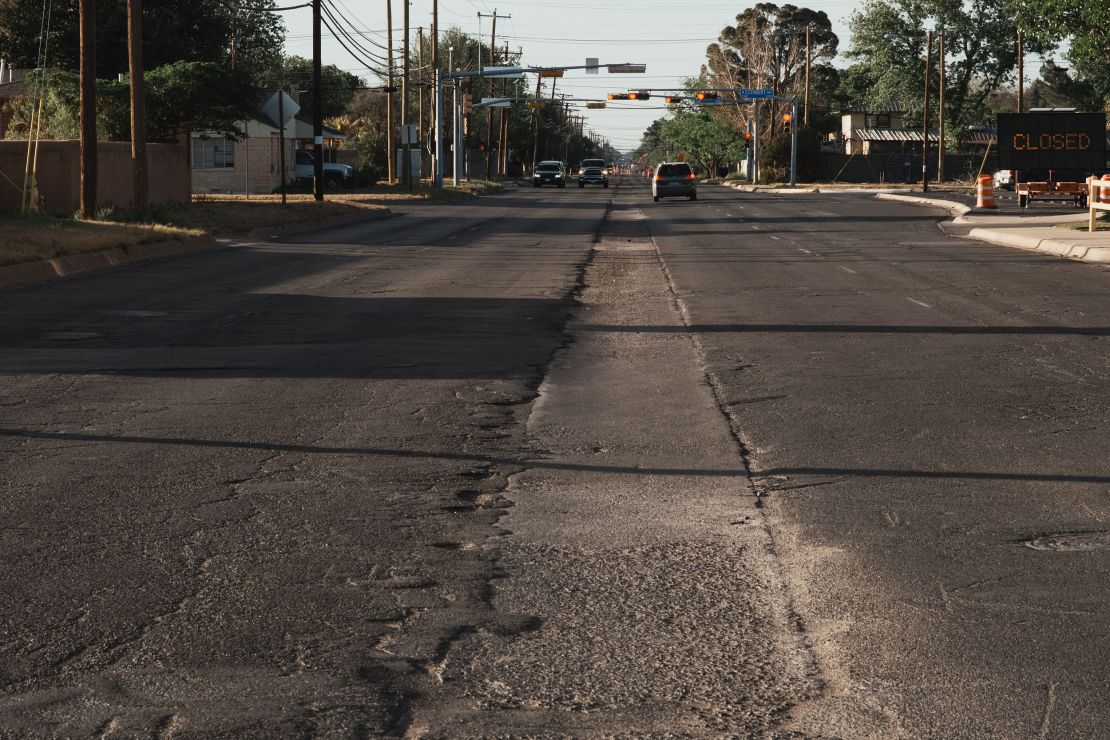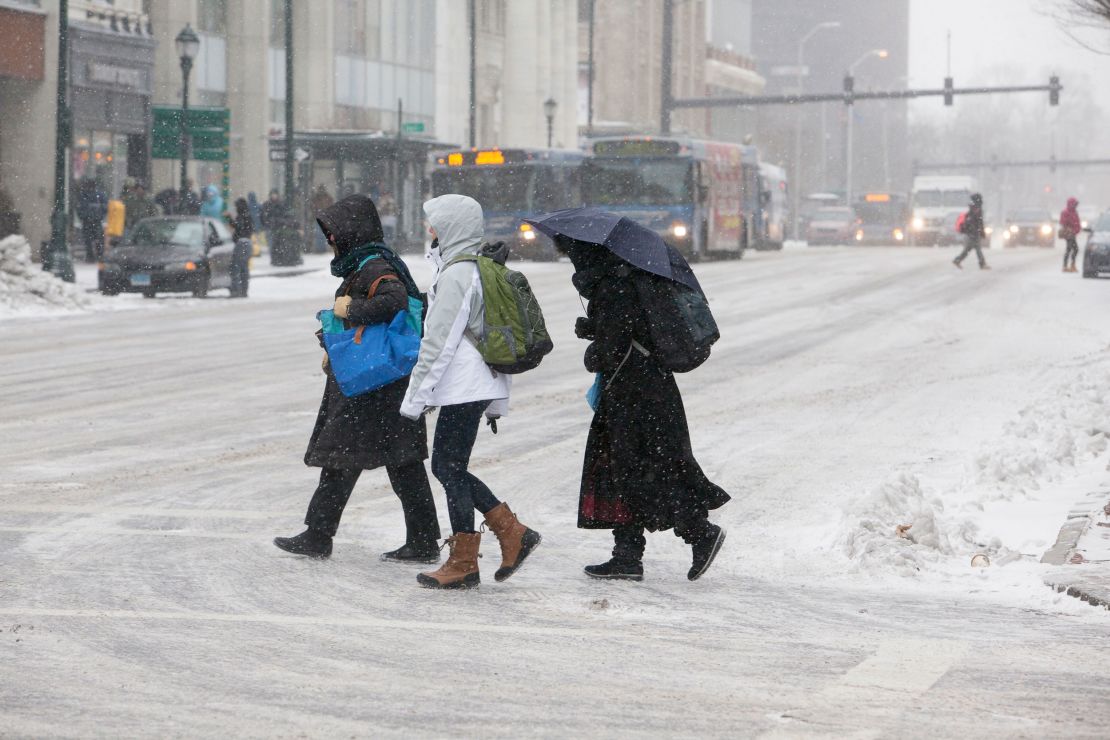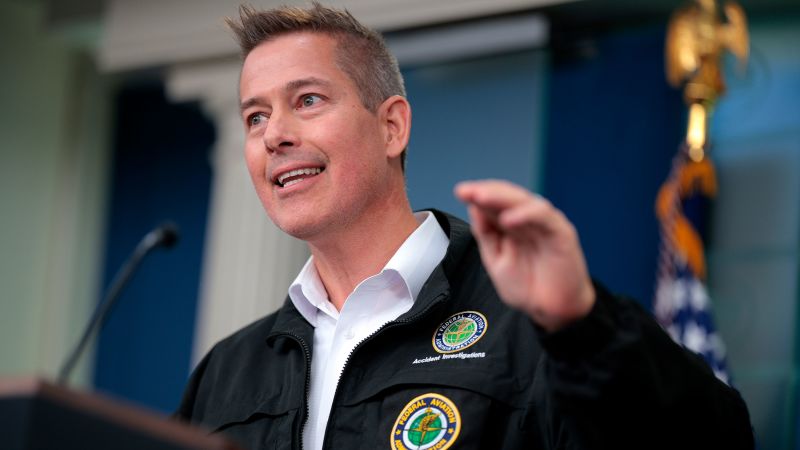CNN
—
In a Fox News segment last year on America’s declining birth rate, former congressman Sean Duffy joked about how he would “lose count” of his nine kids, and urged viewers to follow his lead in having more children.
“If you look at what’s good for country and society, it’s to reproduce, to have kids,” Duffy declared. “That shows that you’re healthy, you’re strong, and you’re patriotic.”
Now, in his new position in President Donald Trump’s cabinet, Duffy is writing that philosophy into an unlikely area of federal policy: transportation funding.
The day after he was sworn in as Secretary of Transportation, Duffy issued a four-page memo to align the department’s grants with what he described as “sound economic principles.” One of his new directives: the department should give a “preference to communities with marriage and birth rates higher than the national average” in programs and funding.
That move could end up disproportionately benefiting pro-Trump areas, according to a CNN analysis of Census and health data and other research charting the wide variations in birth and marriage rates around the US.
Duffy’s order – which was foreshadowed by his public warnings that a falling birth rate is a “crisis” for the country – echoes rhetoric pushed by conservative activists and Trump allies like Elon Musk and Vice President JD Vance, who have long raised the alarm about the declining numbers of births and marriages.
The transportation policy would lead to new winners and losers: Fast-growing metros in Texas and Western states that are home to many young adults appear poised to take in more funding, while college towns with fewer people tying the knot and having kids could come up short.
“Making babies has nothing to do with making roads,” said Justin Elicker, the Democratic mayor of New Haven, Connecticut, which has among the lowest birth and marriage rates of mid-to-large size cities in the US. “This seems clearly designed to prioritize funding for red states.”
Duffy, a former congressman and reality TV star, has defended the policy as a reasonable investment strategy, at a time when the department’s funding could face significant cuts under GOP budget proposals.
“When communities have kids and families, that’s where you see growth,” Duffy told reporters last month. “We want to invest in growth, and it’s only one factor that we’re going to consider as we look at where we put our money.”

The policy appears to be unprecedented, experts said. In 25 years of working in transportation planning and demography, “I’ve never seen anything like this,” said Beth Jarosz, senior program director at the Population Reference Bureau, a nonprofit that analyzes US demographic trends. But she noted that “there’s a lot more guidance that’s needed before this could actually truly be implemented.”
It’s unclear, for example, whether federal officials would examine rates at the state level in divvying up funds, or do so at the level of counties or cities. A spokesperson for the Department of Transportation declined to specify how the policy will work in action, or which data and calculations the department will use in determining rates.
Calculating marriage rates in particular is not as simple as it seems. The most straightforward metric would look at the number of marriage licenses approved per resident in a county or state.
But by that measure, Las Vegas and Nevada have by far the highest rates in the country, thanks to the couples who flock to Sin City to tie the knot. Other areas that attract destination weddings, like Hawaii, also have elevated rates. If the DOT uses this way of calculating marriage rates, it could end up boosting plans for high-speed rail and other projects in Nevada: Officials in Las Vegas “might be really happy” about Duffy’s policy, Jarosz said.
To get a more accurate picture of marriage trends around the country, planners could instead use data from the US Census to estimate the rate of couples living in a community who married in recent years. But those kinds of statistics are not easily accessible for less populous areas of the country.
At the state level, data shows that states that voted for Trump tend to have higher birth and marriage rates than those that voted for Democratic presidential nominee Kamala Harris, with places like South Dakota and Utah at the top.
About 70% of the states Trump won were above the national birth rate average in 2023, compared to just 15% of the states Harris won, according to the most recent data from the National Center for Health Statistics. Similarly, 70% of the states Trump won were above the national marriage rate in 2023, compared to 25% of the states Harris won, according to data from the Census’ American Community Survey.
Age plays a big role in explaining the wide variations in birth and marriage rates around the country, said Wendy Manning, a professor at Bowling Green State University and the co-director of the National Center for Family and Marriage Research. Areas that attract young adults who are starting new families have the highest rates of both, while communities that have more retirees and students have lower rates.
Religion also factors in, in part because some studies have suggested Americans who describe themselves as strongly religious tend to have more children and marry at a younger age.
An analysis by the Urban Institute, a research organization, found that the DOT prioritizing high birth and marriage rate areas would mean more transportation funds going to higher-income areas and areas with larger White populations. It would also benefit suburban and exurban areas where almost all trips are made by car – potentially meaning more investment in highways instead of public transit.
Duffy’s policy suggests that “the administration’s approach to funding projects has little to do with the actual benefits that those projects are providing, and a lot more with rewarding certain constituencies,” said Yonah Freemark, a researcher at the institute and a co-author of the study.
A DOT spokesperson said in a statement responding to criticism of the policy that “families and children are the foundation to a strong society, and by investing in them, we invest in the strength and future of our country.”
Currently, most DOT funding is distributed to state governments based on formulas that take into account state population, fuel taxes paid by residents, and other factors. Other DOT programs dole out funds through a competitive process of grant applications from state or local governments for specific projects.
Beyond using birth and marriage rates in determining funding, Duffy has also worked more broadly to reorient the department’s funding to follow the Trump administration’s political goals. He’s threatened to pull funding to New York City’s transit system, criticized California’s high-speed rail project, and ordered a review of efforts to build bike lanes, electric vehicle chargers, and other green infrastructure.

The big winners of Duffy’s birth and marriage rate policy could include places like Midland, Texas, which has had one of the top birth rates in the country of any city with at least 100,000 people in recent years, according to census data. Trump won Midland County with 80% of the vote in 2024.
The city, located in Texas’ Permian Basin, has seen a population boom in recent decades as young people have flocked there for jobs in the oil industry. While Midland has enjoyed economic benefits from the growth, its road network is “built for a city with a much smaller population,” Mayor Lori Blong, a Midland native and oil industry executive, said in an interview.
It’s not uncommon for 18-wheeler oil tankers to rattle through the center of town, which has contributed to Midland County having higher traffic fatality rates than most of the US. And drives across town that took less than 10 minutes when Blong was growing up can now take half an hour or more, she said.
Last year, the City of Midland won an $8.6 million grant from the federal DOT to implement safety measures on a major street through the city. But officials could save more lives from traffic accidents if Midland received a higher rate of federal funds to pursue similar projects around the city, Blong said, describing herself as a strong supporter of Duffy’s policy.
“We’re in a place where we have to have investment in our roadways to keep people safe,” she said.
Notably, counties and metro areas with large populations of college students tend to have lower birth and marriage rates. In New Haven, home to Yale University, officials are bracing for the potential impact of funding cuts, said Elicker, the mayor.
In recent years, the city has won federal grants to improve road safety, speed bus service across town, and start planning to redesign a highway that cuts through neighborhoods near the city’s downtown, splitting communities apart. The highway project is dependent on future federal funding, and without it, major changes are unlikely to happen, Elicker said.
Elicker argued that federal transportation funds could help more people if they’re used for projects in densely populated areas like his city, instead of less populous areas that have higher marriage and birth rates. He said the DOT policy felt like it was designed to punish areas that opposed Trump – about 80% of New Haven voters supported Harris.
“We’re very concerned about it,” Elicker said. “We should be working together as a nation to address our aging infrastructure, instead of creating policies that prioritize some areas over others that aren’t based on facts or actual need.”

Duffy’s policy comes as right-wing groups have advocated for allocating more funding based on birth and marriage rates. Brad Wilcox, a fellow at the conservative Institute for Family Studies, wrote that it was a sign that “cabinet heads and other leaders in Trump 2.0 will be taking a range of creative steps to make good on the new administration’s avowed commitment to make America more family friendly.”
Some key members of Trump’s administration have long focused on declining birth rates, raising the alarm over what they have described as an existential crisis for the US. Vance warned last year that the US doesn’t “have enough families and children to continue as a nation.” And Musk has argued that “population collapse due to low birth rates is a much bigger risk to civilization than global warming.”
But Manning, the Bowling Green family researcher, suggested that if the administration’s goal is to encourage more marriages and kids, it should focus on passing policies like subsidized childcare or paid family leave – not redistributing transportation funds.
“People don’t tell me the reason they’re not having children or getting married is because they don’t have a well-funded bus system,” she said. “It’s a lot to do with feeling uncertain about their future.”

